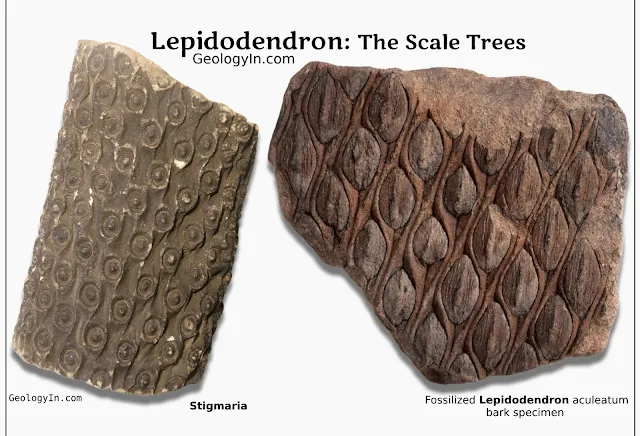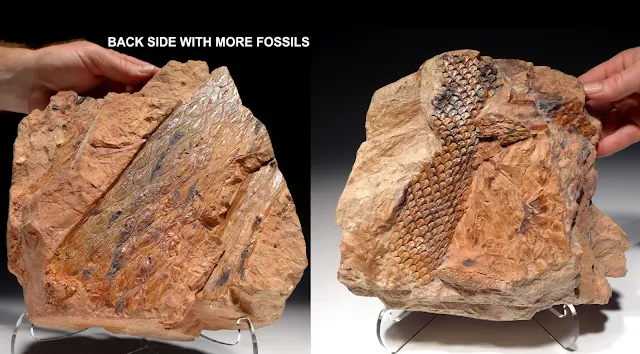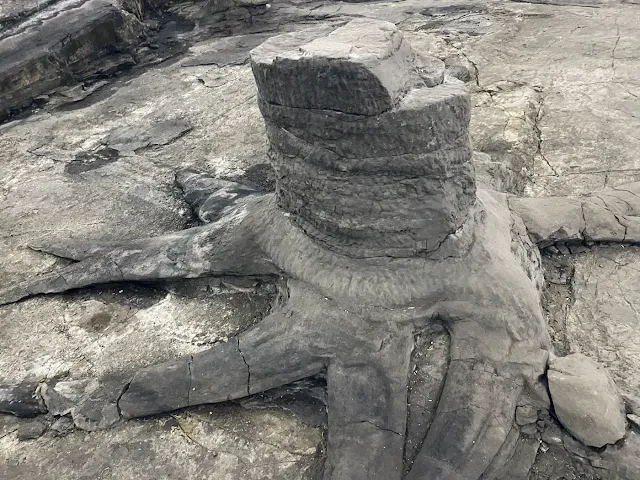Lepidodendron: The Scale Trees
Lepidodendron, commonly known as “scale trees” due to the diamond-shaped leaf scars adorning their trunks, was an extinct genus of arborescent lycophytes that flourished during the Carboniferous Period (~359–299 million years ago). These towering plants reached heights of up to 40 meters (130 feet) and trunk diameters of 1–2 meters, rivaling modern trees in size. However, they were not true trees in the botanical sense. Unlike gymnosperms and angiosperms, Lepidodendron lacked extensive secondary xylem (true wood), reproduced via spores rather than seeds, and possessed a root-like system (Stigmaria) rather than true roots.
Lepidodendron was part of a broader group of vascular plants more closely related to modern quillworts (Isoetes) than to seed plants. Their anatomy and physiology were highly specialized for the humid, low-oxygen conditions of tropical Paleozoic wetlands. These coal swamp ecosystems—dominated by Lepidodendron and other lycopsids—played a pivotal role in the formation of the vast coal beds we mine today.
 |
| Fossilized Lepidodendron specimens – extinct 'Scale Tree' with distinctive diamond-patterned leaf scars from the Carboniferous period. |
Taxonomy and Geological Range
Lepidodendron belongs to the lycophyte lineage, one of the oldest groups of vascular plants. While modern relatives such as clubmosses and quillworts are small and herbaceous, Lepidodendron evolved massive, tree-like forms and became ecologically dominant in Carboniferous swamp forests, particularly in equatorial regions of Euramerica.
Taxonomic Classification
- Kingdom: Plantae
- Division: Lycopodiophyta
- Class: Isoetopsida
- Order: Lepidodendrales
- Family: Lepidodendraceae
- Genus: Lepidodendron (Sternberg, 1820)
Lepidodendron first appeared in the Late Devonian and rose to prominence during the Carboniferous Period, especially in the Pennsylvanian Subperiod (~323–299 million years ago). While its dominance waned toward the close of the Carboniferous, the genus persisted regionally into the early Permian, particularly in areas such as Cathaysia (now southeastern China).
 |
| Lepidodendron trunk fragment with well-preserved leaf base scars and rhombic cushion patterns. |
Morphology and Structure
Size and Growth Form
Lepidodendron trunks soared 30–50 m (100–165 ft) tall and measured up to 1–2 m (3–6 ft) across, yet lacked secondary wood. Instead, a thick peripheral cortex of water-laden parenchyma bore most of their load, making these giants anatomically more akin to colossal herbs than true woody trees. Most of the stem was unbranched; only near the canopy did dichotomous (Y-shaped) divisions form a crown of leafy axes.
Trunk Surface
The name Lepidodendron (“scale tree”) derives from its spirally arranged, diamond- to hexagon-shaped leaf scars, or cushions, marking former leaf attachments. In juveniles, cushion tissues likely carried out photosynthesis; in mature bark, they mainly provided support and facilitated decay into peat.
Leaves (Microphylls)
Long, narrow microphylls (sometimes up to 1 m) sprouted spirally from stems and branches. As the plant grew, older leaves abscised, leaving the characteristic cushions and suggesting that even the trunk remained photosynthetically active via persistent cushion tissue.
Root System (Stigmaria)
Beneath the swamp floor lay sprawling, horizontally branching rhizomes called Stigmaria. These bore tiny, helically arranged rootlets—each leaving a circular scar—efficiently absorbing water and nutrients in waterlogged soils. Fossils of Stigmaria are common indicators of Carboniferous peat-forming environments.
 |
| Lepidophloios and Lepidodendron fossil bark specimens preserved together. Upper Silesia Basin, Poland. |
Reproduction: Spore-Based Strategy
Lepidodendron reproduced via heterospory, producing two distinct types of spores:
- Microspores (male)
- Megaspores (female)
These spores were housed in strobili—cone-like structures called Lepidostrobus—positioned at the tips of branches. In some species, Lepidocarpon preserved megaspores within protective enclosures, suggesting early seed-like adaptations. As with other lycophytes, Lepidodendron relied on water for fertilization; motile sperm required a moist substrate to reach the egg.
The life cycle involved free-living gametophytes, which developed from spores and produced gametes independently. Some fossil evidence supports the hypothesis that Lepidodendron was monocarpic, completing its life cycle in a single reproductive event before dying—possibly within 10–15 years—though this may not apply to all species.
Paleoecology and Habitat
Coal Swamp Dominance
Lepidodendron flourished in the wet, tropical lowlands of Carboniferous Euramerica (now North America and Europe), where its rapid growth and limited tissue decay in anoxic conditions helped accumulate the vast organic layers that became coal.
Ecological Role
- Formed dense, often monospecific stands in lowland swamps
- Exhibited fast growth and short lifespans (~10–15 years)
- Contributed significantly to high atmospheric oxygen levels (~35%) during the late Paleozoic
- Played a crucial role in the global carbon cycle, sequestering massive amounts of carbon through burial in swamp deposits
Fossil Record and Geological Significance
Fossils of Lepidodendron are abundant in Pennsylvanian-age coal beds (~323–299 Ma), making it one of the most recognizable plants of the Paleozoic fossil record. Key fossil forms include:
- Lepidodendron – Trunk and stem segments with diamond-shaped leaf scars
- Lepidophylloides – Detached, grass-like leaves
- Lepidostrobus – Reproductive cones (strobili)
- Lepidocarpon – Megasporangia containing enclosed spores
- Stigmaria – Horizontal rooting structures with helical rootlet scars
Fossils occur as compressions (e.g., preserved bark impressions) and permineralizations (e.g., cellular details), providing valuable insights into Paleozoic ecosystems and paleoclimates. These remains frequently occur alongside other swamp flora such as Sigillaria, Calamites, and Cordaites.
 |
| 330-million-year-old Lepidodendron stumps in situ at Fossil Grove, Glasgow. |
Extinction and Legacy
By the late Carboniferous, major climatic and ecological shifts—especially increasing seasonality, global cooling, and aridity—led to the decline of the wetland ecosystems that sustained giant lycopsids like Lepidodendron. As coal swamps contracted, Lepidodendron populations diminished, unable to compete with more drought-tolerant seed plants, including conifers and pteridosperms (seed ferns). By the end of the Permian Period (~252 Ma), Lepidodendron and other arborescent lycophytes had disappeared entirely, likely extinguished by the Permian–Triassic mass extinction, the most severe extinction event in Earth’s history.
Key Drivers of Extinction
- Climate shift: Increasing aridity and cooler global temperatures reduced the extent of swamp forests.
- Ecological Competition: Seed-bearing plants outcompeted lycopsids in the emerging dryland environments.
- Geological Disruption: Tectonic uplift and fluctuating sea levels altered or eliminated lowland wetland habitats.
- Reproductive Limitation: As probable monocarpic organisms with water-dependent fertilization, Lepidodendron may have struggled to adapt to fragmented and drier ecosystems.
Smaller, non-arborescent lycophytes survived into the Permian and continue today as quillworts and clubmosses, but the giant tree forms vanished permanently.
 |
| Lepidodendron stumps at Glasgow's Fossil Grove - 325MY fossilized trees standing where they grew near the Paleozoic equator (Credit: John Devlin). |
Paleobotanical Legacy
Despite its extinction, Lepidodendron left a profound impact on both Earth’s geological record and modern society:
- Coal Formation: Its thick, water-rich tissues contributed significantly to Carboniferous peat accumulation, forming many of the coal seams that fuel today’s energy production.
- Fossil Significance: Diamond-patterned bark fossils are among the most recognizable plant fossils of the Paleozoic, often used as index fossils for dating Carboniferous strata.
- Evolutionary Role: Lepidodendron represents a unique evolutionary path to arborescence without true wood, relying instead on a turgid cortex for mechanical support.
- Paleoecological Insights: Its remains help reconstruct ancient swamp ecosystems, Carboniferous climate patterns, and early vascular plant evolution.
Did You Know?
1. Lepidodendron looked like a tree, but it didn’t have real wood.
Instead of strong woody tissue like modern trees, it had a thick, water-filled outer layer (called the cortex) that helped it stand tall—kind of like an inflated water balloon.
2. Its diamond-shaped bark patterns are famous fossils.
These leaf scars covered the trunk in a scaly pattern and are some of the most recognizable plant fossils from the Paleozoic Era. You can often see them on display in natural history museums.
3. Lepidodendron probably reproduced only once in its life.
Scientists think it was monocarpic—meaning it grew for many years, produced cones just once, and then died. This is similar to how some modern plants like bamboo or agave reproduce.
4. It lived in a time when giant insects filled the skies.
During the Carboniferous Period, oxygen levels were much higher than today—up to 35%. This allowed insects like Meganeura, a dragonfly with a wingspan over 2 feet (70 cm), to grow to enormous sizes.
Read also:
Green Petrified Wood from Arizona
23 Fascinating Facts About Fossils



%20(1).webp)





